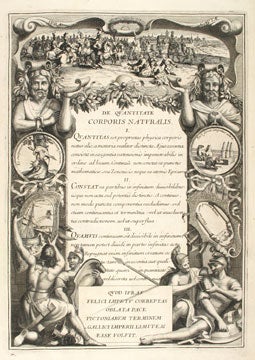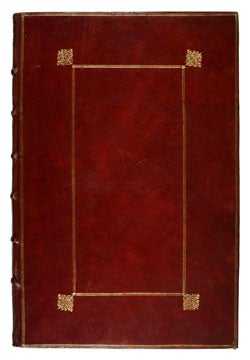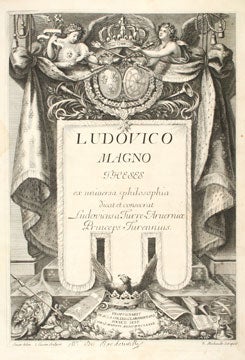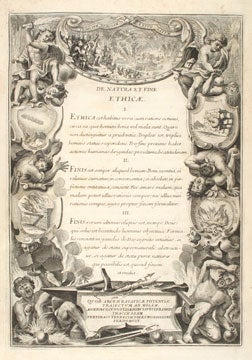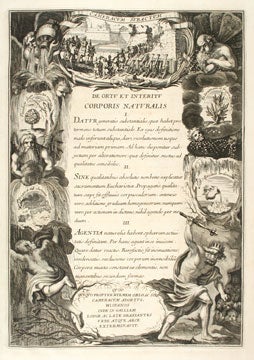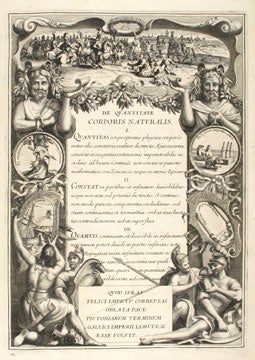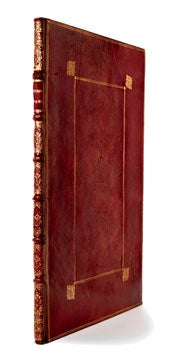Ludovico Magno theses ex Universa Philosophia.
MENESTRIER, Claude-François. -- LA TOUR D'AUVERGNE, Louis Charles de, Prince de Turenne. Ludovico Magno theses ex universa philosophia dicat et consecrat Ludovicus a Turre-Arverniæ princeps Turennius. [16] pp., (page [4] blank). Engraved throughout: calligraphic title and text engraved by Louis Michault within elaborate emblematic and historiated borders engraved by Louis Cossin (i.e., Coquin) after Pierre-Paul Sevin. [Clermont Ferrand?], 1679. BOUND WITH:
MENESTRIER, Claude-François and René d'ORIVAL. "A son Altesse Serenissime Monseigneur Louis-Auguste Prince Souverain de Dombes, sur son Imprimerie de Trévoux…" 4 ff., folio (405 x 267 mm.), deckle edges. [N.p., ca. 1701-1704]. Folio, 447 x 300 mm, bound in early 18th-century French red morocco gilt, sides paneled à la Du Seuil with inner and outer triple fillets, arabesque lozenge tools at corners of inner panel, spine intricately gold-tooled in compartments, title gilt-lettered in second compartment, marbled endpapers, gilt edges.
A splendid association copy of the First Edition of this magnificently-illustrated thesis in philosophy, printed in only a very few copies for private circulation. The large, full-page engraved plates are impressive: full of allegorical, mythological, emblematic and symbolic imagery. They were designed by the Jesuit monk and antiquarian Claude-François Menestrier.
Dedicated to Louis XIV, the edition is imaginatively illustrated, with an engraved title lettered on a banner set before a background of drapery, emblems of the arts and sciences at foot, and at top a pair of allegorical figures holding the Prince's arms; a medallion portrait of the King within an allegorical composition of putti and mythological figures; and 12 pages of engraved text, each within a different elaborate and carefully conceived allegorical page border, containing mythological and allegorical figures ("énigmes") and four emblems or emblematic scenes within cartouches. 28 of the emblems were devised by the Jesuit antiquarian and homme de lettres Claude-François Menestrier, whose manifold interests included heraldry and emblem theory.
At the top of each engraving is a detailed scene representing one of the military exploits of the last two campaigns of Louis XIV, most with Latin inscriptions, several also conceived by Menestrier, and the others by le père La Rue, who wrote the dedicatory epistle. The title is signed by Louis Cossin (né Coquin), after Pierre-Paul Sevin; the remaining engravings are incorrectly attributed by Guilmard and the authors of Inventaire du fonds français to Cossin, who simply reproduced in engraving the original compositions of Sevin, a Lyonese painter known for his renderings of historical scenes, portraits and emblematic suites.
Bound at the end is an undated pamphlet containing laudatory verses by Menestrier and René d'Orival in French and Latin. The first long poem, in French alexandrines, is dedicated to Louis-Auguste de Bourbon, Prince de Dombes (and Duc de Maine) and praises the royal press of Trévoux, founded in 1603 but only achieved prominence under Louis-Auguste's patronage. Also mentioned is the new Catholic French-Latin Dictionnaire universel français et latin, later known as the Dictionnaire de Trévoux, which the press published in 1704. The Dictionnaire is also the subject of one of the shorter Latin poems by Menestrier; according to Allut this appeared in the prefatory material of the Dictionnaire itself. The pamphlet may therefore date to 1704, or it may have been printed before publication of the completed dictionary; in his bibliography Allut places it amongst imprints from 1701. Some minor marginal discoloration, else an impeccable and beautifully bound copy of an extremely rare masterpiece of seventeenth-century French book illustration. A single copy is recorded in an American library (Getty Research Institute). Few survive, and fewer still in the splendid condition of the present copy.
PROVENANCE: de Bardonelle, contemporary signature at foot of title; Paul Allut, inscription on front flyleaf (sale 10 Feb. 1868); Joseph Renard, bookplate (sale, 21 March 1881, OR 12 May 1884). This copy is especially distinguished in that BOTH the principal bibliographers and biographers of Menestrier, Paul Allut, author of the Recherches sur la vie et sur les œuvres du P. Claude François Menestrier (Lyon, 1856), and Joseph Renard, whose Catalogue des oeuvres imprimées de Claude-François Menestrier was posthumously edited by Carlos Sommervogel and appeared at Lyon in 1883 were owners.
I) Guilmard, Les Maîtres ornemanistes I:87, 24. Inventaire du fonds français, graveurs du XVIIe s. III:172, 98-111. Allut, Recherches pp. 153-4, LXV. Renard, Catalogue pp. 52-53, LXIX. II). Allut pp. 192-3. Rawles and Saunders in their Bibliography of French emblem books of the sixteenth and seventeenth centuries. F.570.
Item nr. 166958
Price:
$18,500.00

